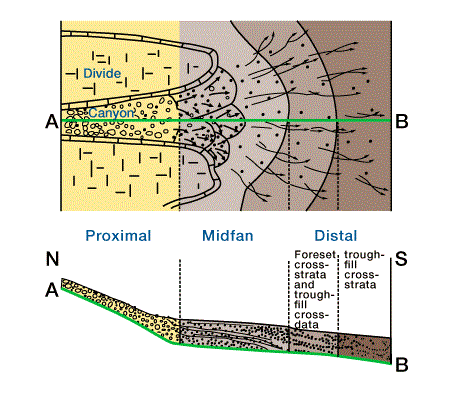Geometry
The size and detailed morphology of fans will vary according to climate, source rock, basin architecture, and the degree and style of tectonic activity. Individual fans are normally wedge-shaped in plain view and concave-upward in cross section. (Figure 1 Plan view of cross section of a single canyon and the alluvial fan which developed at its mouth, Van Horn Sandstone, Precambrian (?) Texas.

Shown are the downfan decrease in slope and grain size, as well as the higher concentration of sedimentary structures in the distal portions. The overall progression grades from massive conglomerate/gravel of the proximal fan, through alternating trough and foreset crossbedded sand of the midfan, to finer-grained, more thinly bedded crossbedded sands of the distal fan.) They may also reveal a lens-like morphology in the subsurface. Fans can have radii that range from hundreds of feet to tens of miles. Bajadas can be over 100 miles long, though considerably narrow in width. Sections have been measured up to several thousand feet thick, with separate conglomerate-sand sequences showing lateral continuity of up to about 1500 ft. Clay layers are much more localized and thin. Commonly, a fan or fan complex will be thickest at its proximal end, having, for example, filled in a rapidly subsiding local graben.
 Petro Shine The Place for Oil and Gas Professionals.
Petro Shine The Place for Oil and Gas Professionals.



